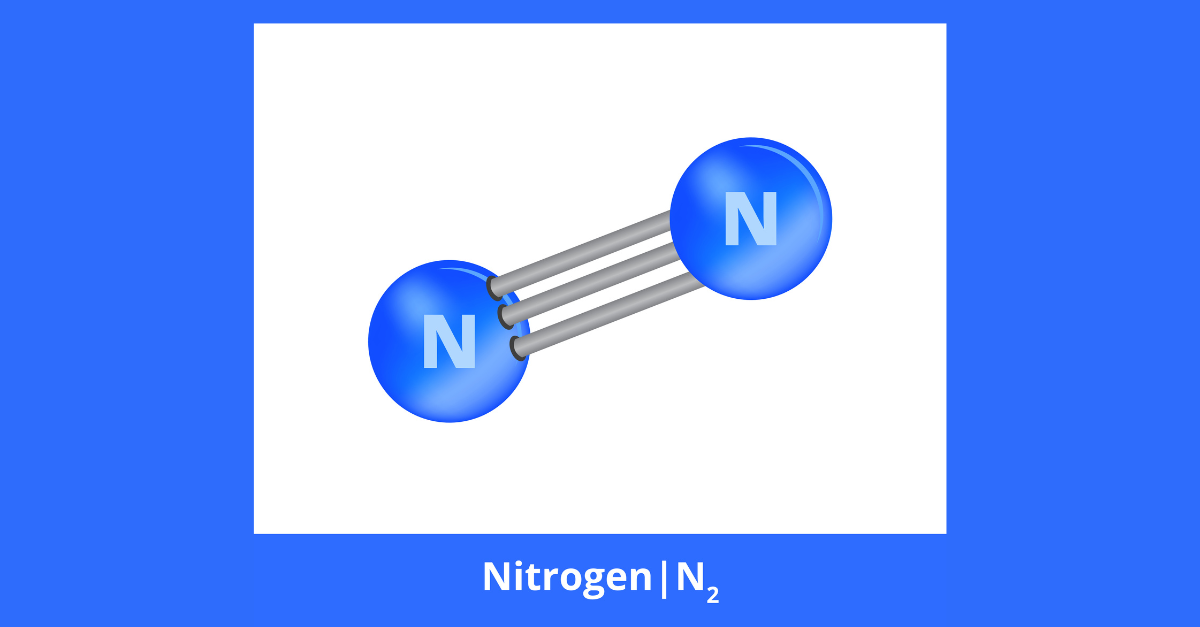Khí nitơ (N2): Chi tiết lý thuyết và bài tập áp dụng

Nitrogen is a chemical element that makes up about 78% of Earth’s atmosphere and is a component of all living organisms. The entire basic theory of nitrogen gas such as: Concept, properties, applications and preparation will be answered in the most detail in the article below.
- 50+ bài tập toán nâng cao lớp 2 có đáp án cùng bé ôn tập hiệu quả
- Danh sách bài tập đạo hàm trắc nghiệm từ dễ đến khó giúp học sinh rèn luyện mỗi ngày
- Có bao nhiêu dấu câu trong tiếng Việt ?
- Tổng hợp về hiện tại đơn quá khứ đơn tương lai đơn đầy đủ
- Muối cacbonat: Khái niệm, phân loại, tính chất và ứng dụng
What is nitrogen gas?
Concept: Nitrogen (English name nitrogen) is a chemical element in position 7, period 2, belonging to group VA in the periodic table.
Bạn đang xem: Khí nitơ (N2): Chi tiết lý thuyết và bài tập áp dụng
Symbol: N2 and usually exists in gas form with a 3 bond.
Atomic electron configuration: 1s2 2s2 2p3. Thus, the electron structure of N2 consists of 2 layers, the outer shell has 5 active electrons. Therefore, this gas is considered a highly reactive nonmetal.
Structural formula: N ≡ N
Natural state of nitrogen
After knowing what nitrogen gas is, let’s learn about its forms of existence around us. In nature, nitrogen exists in free and compound forms.
.jpg)
-
Natural nitrogen makes up 78.16% of air volume, a mixture of two isotopes: 14/7N (99.63%) and 15/7N (0.37%)
-
Nitrogen as a compound is abundant in sodium nitrate NaNO3 called sodium saltpeter.
-
Nitrogen is present in all living organisms, mainly in the form of amino acids (proteins) and also in nucleic acids (RNA and DNA). According to research, the human body contains about 3% nitrogen by weight. It is the fourth most common element in the body after oxygen, carbon and hydrogen.
Physical properties of nitrogen gas
Here are the basic physical properties of nitrogen that you need to remember:
.jpg)
-
Nitrogen is a colorless, odorless, tasteless gas with a mass lighter than air N2=28, also known as nitrogen gas.
-
Slightly soluble in water (under normal conditions, 1 liter of water can dissolve 0.015 liters of nitrogen gas)
-
The liquefaction temperature is – 196 degrees Celsius and the solidification temperature is also very low. Liquid nitrogen is a compound that resembles water but is only 80.8% nitrogen at the boiling point, with a dielectric constant of 1.4.
-
Does not sustain combustion and life.
Chemical properties of nitrogen
So what are the chemical properties of nitrogen?

-
Nitrogen is a substance with very strong triple bonds, even at 3000*C it is still not clearly decomposed into atoms.
-
At normal temperatures, Nitrogen is chemically inert but becomes more active and can react with many substances at high temperatures.
-
In covalent compounds of nitrogen with less electronegative elements (such as hydrogen, metals…), nitrogen has a -3 oxidation state.
-
In covalent compounds of nitrogen with more electronegative elements (oxygen, chlorine, fluorine), nitrogen has a positive oxidation number, from +1 to +5.
Thus, when participating in oxidation-reduction reactions, nitrogen can reduce or increase the oxidation number. For this reason, nitrogen has both oxidizing and reducing properties. In particular, oxidation is the main property of N2.
Nitrogen has oxidizing properties
With most metallic elements, nitrogen will act at high temperatures, showing oxidation properties when reducing the oxidation number from 0 to -3 with the catalysts of hydrogen gas, temperature, and pressure. Except for the case of effect with Li (can work under normal conditions).
Reacts with metals
At high temperatures, nitrogen shows oxidation properties when it reacts with some highly active metals such as Ca, Mg, Al… and forms metal nitrides.
For example:
3Mg + N2 → Mg3N2 (temperature)
0 -3
Reacts with hydrogen
At high temperature, high pressure and in the presence of a catalyst, nitrogen can react directly with hydrogen to create ammonia according to the equation:
N2 + 3H2 → ← 2NH3 (temperature, P, catalyst)
0 -3
In this reaction, nitrogen exhibits oxidizing properties when the oxidation number decreases from 0 to -3.
Nitrogen has reducing properties
At a temperature of about 3000 degrees Celsius (or exposed to an electric spark), nitrogen will show reduction properties when combined directly with oxygen and create nitrogen monoxide NO according to the equation:
N2 + O2 → ←2NO (temperature)
0 +2
Thus, nitrogen shows reducing properties when the oxidation number increases from 0 to +2. This substance will turn reddish brown in air to form NO2.
Nitrogen oxide is a group of compounds – products created by two elements N and O. They will have different properties and different uses depending on the structure. For example: N2O is a laughing gas, harmful to the brain, NO2 is an ingredient that pollutes the environment, is used in medicine or is used as an ingredient in chemical fertilizers.
How to prepare nitrogen?
There are many ways to prepare N2 but below are some of the most popular methods.
.jpg)
Preparation of nitrogen in the laboratory
In the laboratory, pure nitrogen is prepared by gently heating a saturated solution of ammonium nitrite salt (or alternatively ammonium chloride and sodium nitrite).
Equation:
NH4NO2 → N2 (↑) + 2H2O (temperature)
NH4Cl + NaNO2 → N2 (↑) + NaCl + 2H2O (temperature)
Besides, to prepare nitrogen in the laboratory, one can also heat ammonium dichromate (NH4)2Cr2O7 or thermally decompose Sodium Azide or Barium Azide.
Nitrogen production in industry
Industrially, nitrogen is produced by fractional distillation of liquid air under high pressure and extremely low temperature after removing CO2 and water vapor. When the liquid air temperature is raised to -196 degrees Celsius, the nitrogen boils and is removed.
.jpg)
Besides, nitrogen in industry is also prepared by mechanical membrane filtration method using pressure (PSA).
These are two of the ways to prepare N2 to create many products and cost as little as possible. Nitrogen is transported in steel tanks with a compression pressure of 150atm.
See more:
Applications of nitrogen in life and industry
What role does nitrogen gas play in our lives? Nitrogen gas is useful or harmful, how to use it? Let’s learn about the applications of nitrogen in life and industry in 3 forms: Nitrogen gas, nitrogen compounds and liquid nitrogen gas.
.jpg)
Application of nitrogen compounds
Molecular nitrogen in the atmosphere is relatively inert, but in nature it is converted very slowly into biologically and industrially useful compounds. Nitrogen incorporation or fixation is an important feature in the modern chemical industry. Nitrogen is converted into ammonia – this substance can be used directly as fertilizer or become a raw material for many important chemicals such as explosives and rocket fuel.
Application of liquid nitrogen gas
What is liquid nitrogen? Liquid nitrogen is nitrogen in a liquid state, its temperature is extremely low (about -196 degrees Celsius), it can destroy everything related to life. It is one of the industrial gases and has wide applications.
.jpg)
Industrially produced liquid nitrogen is known as a refrigerant that can instantly harden living tissue upon contact. It serves as a concentrator and carrier of uncompressed gaseous nitrogen. Additionally, it can maintain temperature surprisingly well. With the ability to evaporate at 77 K (-196°C or -320°F), liquid nitrogen is extremely useful in a variety of applications, such as:
-
Refrigerate food during transport.
-
Preserve biological samples and products (body parts or sperm and egg cells…).
-
Used in many studies of refrigerant agents.
-
Illustration in education.
-
Removes malignant or potentially cancerous skin lesions (warts, calluses on the skin, etc.)
-
Cooling power to accelerate CPU, GPU, or other types of hardware.
Application of nitrogen gas
Gaseous nitrogen is produced rapidly by warming and evaporating liquid nitrogen. This gas has many common applications such as:
-
Preserves the freshness of packaged foods (by slowing down oxidation).
-
Ensure safety for liquid explosives.
-
Manufacture of electronic components (such as transistors, diodes, and IC integrated circuits).
-
Producing stainless steel, inflating car and aircraft tires.
-
Used as a favored alternative to carbon dioxide to pressurize tanks holding certain types of beer. It produces less foam, which makes the beer smoother and heavier.
Exercises about nitrogen in Chemistry Textbook Grade 11 with detailed explanations
Let’s apply the detailed theories about nitrogen in the above sections to practice some basic exercises in the Grade 11 Chemistry Textbook below.
_(1).jpg)
Solve problem 1 page 31 of Chemistry textbook grade 11
Describe the structure of the N2 molecule? Why is nitrogen an inert substance under normal conditions? Under what conditions does nitrogen become more active?
Solution:
Electron configuration of nitrogen: 1s22s22p3
CTCT of nitrogen molecule: N ≡ N
Between two atoms in the N2 molecule, a stable triple bond is formed. Each nitrogen atom in the N2 molecule has 8 electrons in the outer shell, including three shared electron pairs and one paired electron pair.
Under normal conditions, nitrogen is very inert because there is a stable triple bond between the two atoms. At 3000 degrees Celsius, the bond is not clearly decomposed into atoms.
At high temperatures, nitrogen becomes active because the N2 molecule decomposes into a nitrogen atom with 5e in the outer shell and has a relatively high electronegativity (3.04), so it becomes active.
Solve lesson 2 of Chemistry textbook grade 11, page 31
Nitrogen does not maintain respiration, is nitrogen a toxic gas?
Solution: Nitrogen is not a toxic gas even though it does not sustain life and combustion.
Solve problem 3 in textbook page 31 Chemistry 11
a. Find the correct pairs of formulas for lithium nitride and aluminum nitride:
A. LiN3 and Al3N
B. Li3N and AlN
C. Li2N3 and Al2N3
D. Li3N2 and Al3N2
b. Write the chemical equation for the reaction that forms lithium nitride and aluminum nitride when lithium and aluminum react directly with nitrogen. In these reactions is nitrogen an oxidizing agent or a reducing agent?
Solution:
a. Answer B
When bonded with metals, nitrogen easily accepts 3e (Nitrogen has 5e in the outermost layer so it has an oxidation number of -3, while Li easily gives up 1e and Al easily gives up 3e so it has oxidation numbers of +1 and +3 respectively). .
b.
6Li + N2 → 2Li3N
0 0 +1 -3
2Al + N2 → 2AlN
0 0 +3 -3
We see that in the above reactions nitrogen is the oxidizing agent because:
N2 + 6e → 2N
0 -3
Solve problem 4 page 31 Chemistry 11 textbook
What is the oxidation number of the element nitrogen in the following compounds: NO, NO2, NH3, NH4Cl, N2O, N2O3, N2O5, Mg3N2?
Solution:
In the above compounds, the oxidation numbers of nitrogen are: +2, +4, -3, -3, +1, +3, +5, -3.
Solve lesson 5 Chemistry 11 textbook page 31
How many liters of nitrogen and hydrogen gas are needed to prepare 67.2 liters of ammonia gas? Knowing that the volume of the gases is measured at the same temperature and pressure conditions and the reaction efficiency is 25%?
Solution:
We see that the volume ratio is the same as the mole ratio:
N2 + 3H2 → 2NH3 (P, temperature, catalyst)

The mole ratio is also the volume ratio
According to the equation:
V(N2) = 1/2 x V(NH3) = 1/2 x 67.2 = 33.6liter
V(H2) = 3/2 V(NH3) = 3/2 x 67.2 x 100.8liter
Since the reaction efficiency is 25%, the volumes of nitrogen and hydrogen needed are:
V(N2) = 33.6 x 100/25 = 134.4 liters
V(H2) = 100.8 x 100/25 = 403.2 liters
Thus, the above article has helped readers gain more basic knowledge about nitrogen, including: What is nitrogen, physical and chemical properties, applications and nitrogen preparation. Nguyễn Tất Thành hopes this information will be useful for your learning process. Don’t forget to visit Nguyễn Tất Thành’s website every day to receive many other interesting lessons about Math, Physics, and Chemistry at all levels!
Nguồn: https://truongnguyentatthanh.edu.vn
Danh mục: Giáo dục





